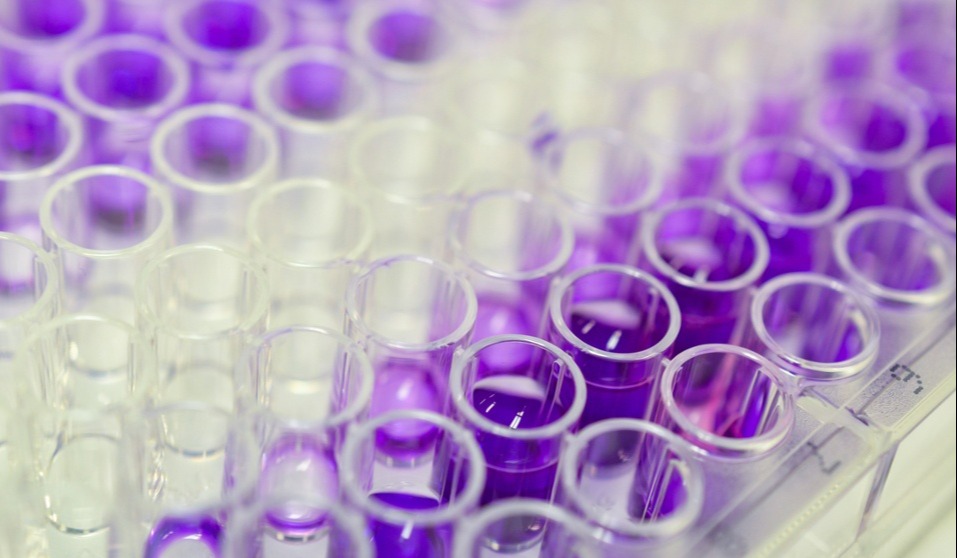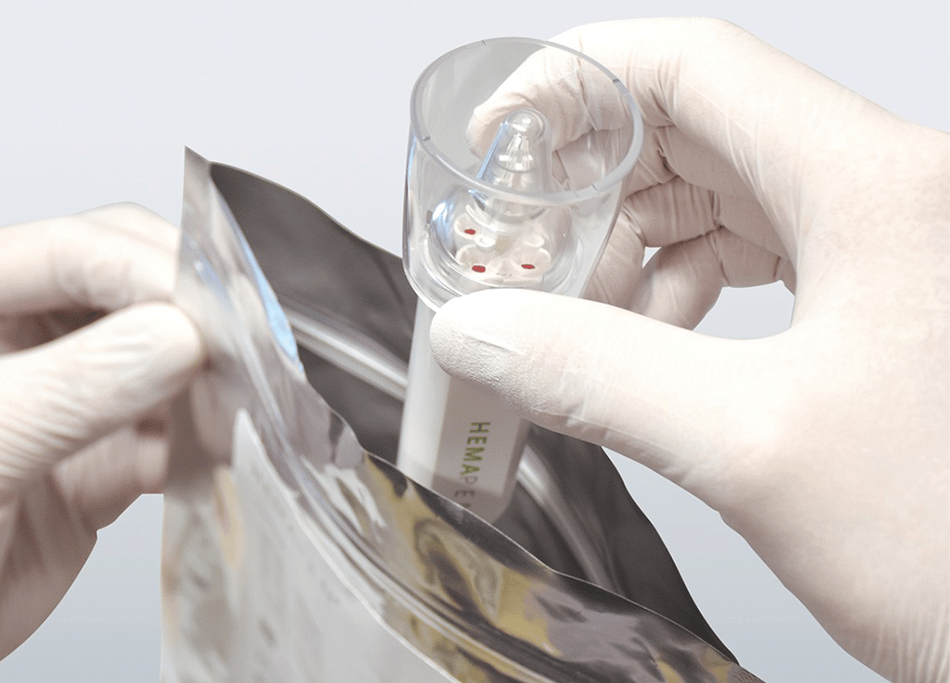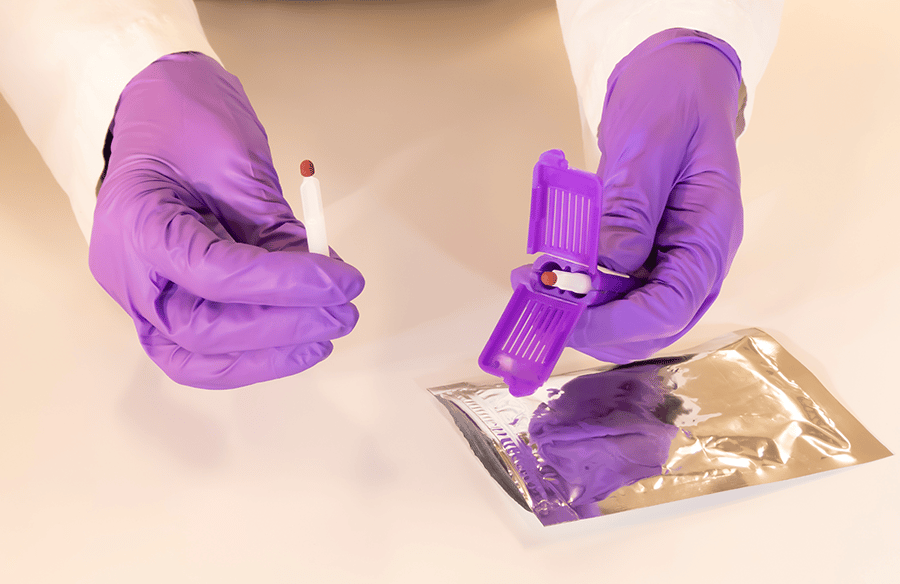Share this
extracting analytes from microsamples using green chemistry approaches
by James Rudge, PhD, Technical Director, Trajan on Jun 27, 2022 9:30:00 AM
An article by Elisabeth Leere Øiestad et al at the University of Oslo and other related institutions, published in the December 2021 issue of Journal of Sustainable Chemistry and Pharmacy, reported on combining a one-step miniaturized sample preparation technique using microsamples collected on Mitra® devices based on VAMS® technology.
The paper is entitled "Green and sustainable drug analysis – Combining microsampling and microextraction of drugs of abuse.” It describes the development and validation of common drugs of abuse analytes using a technique called Parallel Artificial Liquid Membrane Extraction, or PALME.
By combining dried blood microsampling with PALME, the research group was able to conclude that it is possible to conduct low-cost, high sample throughput, semi-automated miniaturized sample preparation to achieve an Eco-Scale score of 78, which fulfills green chemistry principles.
Microextraction and the Value of Green Chemistry
 The world is presently facing many serious challenges and one of those is climate change with regard to the impact humans have on the environment and the earth’s biosphere.
The world is presently facing many serious challenges and one of those is climate change with regard to the impact humans have on the environment and the earth’s biosphere.
With the aim of reducing further environmental harm, one area of focus is to reduce the volume of organic solvents used in all aspects of chemistry and chemical engineering. Many solutions and approaches to this challenge are currently being explored.
One attractive option is to swap toxic or volatile solvents with more environmentally friendly alternatives, wherever possible. In analytical chemistry, scaling down solvent usage has also been a driver to development of microextraction techniques.
Another driver of advances in microextraction is the technological advancement of analytical instrumentation, which is becoming progressively more sensitive.
For example, thousands of metabolomic biomarkers can now be identified from only a few microliters of biological fluid — something that might have been considered “science fiction” only a couple of decades ago.
Microextraction techniques are also becoming highly compatible with extraction of analytes from biological microsamples, such as blood or urine specimens.
These microsamples can be collected from remote microsampling devices, such as Mitra® or hemaPEN® devices.

One such technique is liquid-liquid extraction, which has been used with great success by a number of research groups, including Merck Pharmaceuticals and Wythenshawe Hospital in the United Kingdom (UK). The microsampling work done by these organizations was summarized in a previous blog on the Neoteryx website.
Liquid-liquid extraction employs an aqueous containing solvent to allow blood components to desorb from the microsampling device. However, without adding a clean-up step, injecting these extracts onto an LC-MS/MS instrument can lead to deleterious matrix effects, or even contamination.
Thus, conducting a post liquid-liquid clean-up into a water immiscible organic solvent (such as MTBE) can lead to high extraction efficiency for some analytes and vastly reduced matrix effects. This is a two-step process which can be time-consuming, and also uses organic solvents. Since the goal is to simplify the workflow while also reducing the use of solvents, one solution could be to employ PALME.
An Examination of PALME Methods
PALME (Parallel Artificial Liquid Membrane Extraction) is a way to simulate a “back-extraction” in a one-shot extraction apparatus. Back-extraction is a technique where analytes are extracted from one phase, such as a basic aqueous solvent, into an organic layer.
Following this, a second extraction is conducted utilizing a fresh aqueous layer, which is now acidic. The change in pH suppresses or promotes analyte charge, which in turn promotes association with either layer, dependent on the analyte charge state.
PALME (conducted in 96 well plates) creates a three-way extraction in one step. The assay consists of two wells separated by a filter disk which can accept an organic solvent (~75 µL), forming a supported liquid membrane. The bottom well (donor well) accepts the sample, and a buffer that is set to a pH in order to suppress the analyte of interest. The top well (acceptor) hosts the liquid membrane.
On top of this membrane is a buffer, which is set at a pH to promote analyte ionization. The apparatus is then simply sealed and vortexed using the liquid membrane as an interface and pH gradient. Neutral hydrophobic analytes first partition into the organic layer, then when in contact with the top layer, if they become charged, partition into this. The top layer can then be directly injected onto an LC-MS/MS or is diluted prior to analysis.
A benefit of PALME is the relative low cost (<£1 per well). Moreover, users can fine-tune all three layers and often create a 3 x 3 x 3 extraction method development matrix giving 27 options. Elisabeth Leere Øiestad et al reported that this technique had been previously used on dried blood spot (DBS).
In this study, they embarked on evaluating PALME for the extraction of 13 basic drugs of abuse molecules from Mitra devices, which are based on volumetric absorptive microsampling.
Green Chemistry Study Methods, Results & Discussion
The following drugs were spiked into blood to create calibrators and quality control samples:
- Alprazolam, amphetamine, codeine, diazepam, flunitrazepam, methadone, methamphetamine, morphine, nitrazepam, cocaine, MDMA, oxazepam, oxycodone, THC, zopiclone zolpidem clonazepam and tramadol.
- Mitra microsamples (20 µL) were prepared as calibrators and quality controls.
- Capillary microsamples were collected via finger-stick method from 20 volunteers as part of a roadside testing initiative for drugs of abuse.
- PALME extraction was conducted (vortexing for 1h) from the dried device tips (placed in the acceptor wells) using a 3 x 3 x 3 method development grid for method optimization.
- An analytical validation was conducted following Scientific Working Group for Forensic Toxicology 2013 guidelines. This included LLOD, LLOQ, Calibration modelling, accuracy & precision, extraction recovery & matrix effects, stability & long-term extractability, interference and carryover studies.
- The paper discussed in detail the challenges of optimizing the assay based on the physicochemical properties of the analytes.
- Interesting observations were made, such as employing trioctylamine in the liquid membrane interface to prevent non-specific bonding to the filter material. Moreover, employing the use of an ion pair in the liquid membrane helped to transfer polar bases from the donor to the acceptor solutions. Furthermore, different pH solutions as well as DMSO in the acceptor solution were evaluated based on the pKa and LogP values of the individual analytes. From this, they were able to select the most optimal conditions for most analytes. THC did not extract at all and so was excluded from the results.
- Most analytes showed inter- and intra-day precision <20% with zopiclone and morphine just outside of these limits.
- Recovery was >70% for most analytes and matrix effects were between 80-120% for all but oxycodone and zopiclone (at QC 2 levels).
- Samples were stable on Mitra for 14 days except for zopiclone and zolpidem. A temporal extraction bias was seen primarily in the first 24 hours, so calibrators and QCs were prepared at least 24 hrs after extraction to compensate for this.
- In terms of the roadside test, unfortunately no positives were seen either from the Mitra-VAMS microsamples or from standard blood samples. To simulate positive samples, the group instead used previously stored QC samples to test the method. The group were able to detect all components from VAMS samples, where most had values within 20% of the reported values. However, they did see a positive bias from the VAMS extracts, so commented that capillary venous bridging would be needed for further validation of the method applicability.
- The method was given an excellent ECO-score of 78 (based on a literature method).
Study Authors’ Conclusions
- This was the first reported method to combine VAMS with PALME,
- Most common drugs of abuse were evaluated.
- The validation was within common criteria for many of the analytes.
- Stability was good for most compounds (2 weeks RT).
- Using only 4 µL of organic solvent per well illustrates viability of a green application.
Neoteryx Thoughts and Comments
We are now living in a global society where the term ‘less is more’ is being adopted in many areas and for many reasons. In bioanalytical research studies, less sample volume collected from study participants using devices like hemaPEN and Mitra means more samples can be collected and, thus, more timepoints can be investigated.

Furthermore, more volunteers can be recruited into studies with more efficiency across a wider geographic area, since self-sampling at home is enabled by these remote microsampling devices and the ability to mail the collected samples directly to the lab from the nearest post box.
Indeed, volumetric microsampling using either Mitra devices or the hemaPEN brings many of the aforementioned efficiency benefits to modern bioanalytical workflows.
For example, as reported in a previous blog in this series, a research group showed that it was quicker to process dried microsamples compared to standard wet blood tubes.
To conclude, as we transition away from traditional bioanalytical workflows to microextraction workflows such as PALME, the ‘less is more’ approach is certainly going to continue to bring more benefits to researchers, including reducing harm to the environment through reduced solvent usage.

This study paper was summarized for our readers by James Rudge, PhD, Neoteryx Technical Director. This is curated content. To learn more about the important research outlined in this blog, visit the original paper published in the Journal of Sustainable Chemistry and Pharmacy.
Image Credits: iStock, Neoteryx
You can access this microsampling report and other studies in our Technical Resource Library.
Share this
- Microsampling (206)
- Research, Remote Research (119)
- Venipuncture Alternative (105)
- Clinical Trials, Clinical Research (83)
- Mitra® Device (73)
- Therapeutic Drug Monitoring, TDM (51)
- Dried Blood Spot, DBS (39)
- Biomonitoring, Health, Wellness (30)
- Infectious Disease, Vaccines, COVID-19 (24)
- Blood Microsampling, Serology (23)
- Omics, Multi-Omics (21)
- Decentralized Clinical Trial (DCT) (20)
- Specimen Collection (18)
- Toxicology, Doping, Drug/Alcohol Monitoring, PEth (17)
- Skin Microsampling, Microbiopsy (14)
- hemaPEN® Device (13)
- Preclinical Research, Animal Studies (12)
- Pharmaceuticals, Drug Development (9)
- Harpera Device (7)
- Industry News, Microsampling News (5)
- Antibodies, MAbs (3)
- Company Press Release, Product Press Release (3)
- Environmental Toxins, Exposures (1)
- July 2025 (1)
- May 2025 (1)
- April 2025 (2)
- December 2024 (2)
- November 2024 (1)
- October 2024 (3)
- September 2024 (1)
- June 2024 (1)
- May 2024 (1)
- April 2024 (4)
- March 2024 (1)
- February 2024 (2)
- January 2024 (4)
- December 2023 (3)
- November 2023 (3)
- October 2023 (3)
- September 2023 (3)
- July 2023 (3)
- June 2023 (2)
- April 2023 (2)
- March 2023 (2)
- February 2023 (2)
- January 2023 (3)
- December 2022 (2)
- November 2022 (3)
- October 2022 (4)
- September 2022 (3)
- August 2022 (5)
- July 2022 (2)
- June 2022 (2)
- May 2022 (4)
- April 2022 (3)
- March 2022 (3)
- February 2022 (4)
- January 2022 (5)
- December 2021 (3)
- November 2021 (5)
- October 2021 (3)
- September 2021 (3)
- August 2021 (4)
- July 2021 (4)
- June 2021 (4)
- May 2021 (4)
- April 2021 (3)
- March 2021 (5)
- February 2021 (4)
- January 2021 (4)
- December 2020 (3)
- November 2020 (5)
- October 2020 (4)
- September 2020 (3)
- August 2020 (3)
- July 2020 (6)
- June 2020 (4)
- May 2020 (4)
- April 2020 (3)
- March 2020 (6)
- February 2020 (3)
- January 2020 (4)
- December 2019 (5)
- November 2019 (4)
- October 2019 (2)
- September 2019 (4)
- August 2019 (4)
- July 2019 (3)
- June 2019 (7)
- May 2019 (6)
- April 2019 (5)
- March 2019 (6)
- February 2019 (5)
- January 2019 (8)
- December 2018 (3)
- November 2018 (4)
- October 2018 (7)
- September 2018 (6)
- August 2018 (5)
- July 2018 (8)
- June 2018 (6)
- May 2018 (5)
- April 2018 (6)
- March 2018 (4)
- February 2018 (6)
- January 2018 (4)
- December 2017 (2)
- November 2017 (3)
- October 2017 (2)
- September 2017 (4)
- August 2017 (2)
- July 2017 (4)
- June 2017 (5)
- May 2017 (6)
- April 2017 (6)
- March 2017 (5)
- February 2017 (4)
- January 2017 (1)
- July 2016 (3)
- May 2016 (1)
- April 2016 (2)


No Comments Yet
Let us know what you think